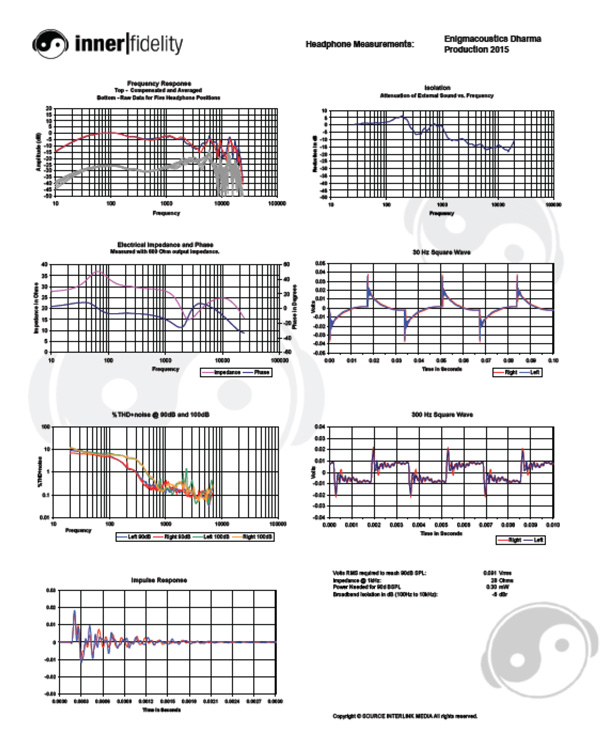| Columns Retired Columns & Blogs |
A Surprisingly Successful Dual Driver Headphone: The Enigmacoustics Dharma D1000 Measurements
Measurements


Click on graphs image to download .pdf for closer inspection.
Raw frequency response plots show the Dharma does fairly well matching the Harman response curve. It does fall short in not having a straight-line bass response below 100Hz, but this is quite common for an open dynamic driver headphone. The wide dip in the mid-range centered at 400Hz would be better if centered at 200Hz.
The climb from 400Hz to 3kHz has a fairly good profile, but should begin to fall off afterward rather than rising to a peak at 5-6kHz. It does seem to me that this peak may shift around depending on the size/shape/position of the ears in the cup. It does appear at 5.5 and 6kHz in a couple different measurements I made, but when I tuned it by ear it seemed centered more at 5kHz.
The response above 6kHz does fall off a bit, but remains at about the same level subsequently 10dB down from the peak. This area should see a downward and slowly increasing slope. The Dharma's frequency response seems to fluctuate more than normal above 6kHz; I suspect we might be seeing constructive and destructive interference from the acoustic signal emitted from the dual drivers.
30Hz response is good for a dynamic headphone. The top of the waveform is somewhat swayback, and echoes the falling response below the primary driver resonance at 700Hz (seen as the leftmost upward hump in the impedance curve). On the other hand, the bass distortion seen in the THD+noise plot below 400Hz on the 90dBspl plot is severe...though oddly doesn't sound nearly as bad as measurements might indicate.
The 300Hz square wave shows fast, but somewhat higher than desired leading edge spike, followed by a significant amount of noise. Noise like this is often seen with electrostatic headphones, but to my eye the magnitude is excessive. It probably results in some of the "tingy-zingy" sound I heard in listening. This noise and excessive ringing is also seen in the impulse response plots. Yet again, the sound I heard seemed somewhat better than the measurements would indicate.
As I mentioned, the bass distortion is quite high in the THD+noise plots, but above around 600Hz it's quite low.
Impedance and electrical phase plot shows a primary driver resonance at about 650Hz, and then a significant feature between 1kHz and 5kHz. I can only interpret this result as the reactance of the various components of the filter network and the electret driver itself. Enigmacoustics claims the electret turns on around 10kHz, but I have a very hard time believing that given this measurement.
This is an open headphone, so it does not provide much, but isolations measurements show it does attenuate outside noise more than most open headphones at roughly 6dB broadband attenuation.
At 91mVrms to achieve 90dBspl at the ear, the Dharma is slightly more efficient than most headphones of this type.
These measurements seem to me much worse than the sound I heard. Another example of measurements not telling the whole story.
- Log in or register to post comments




































